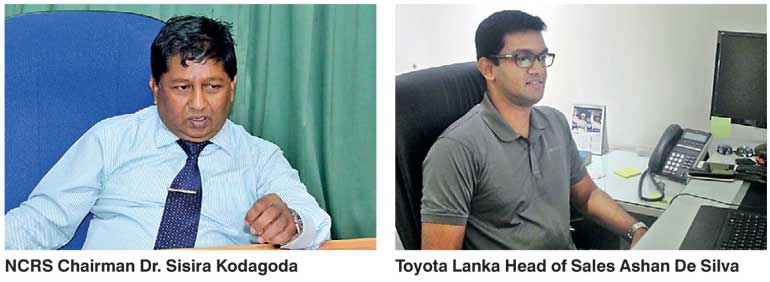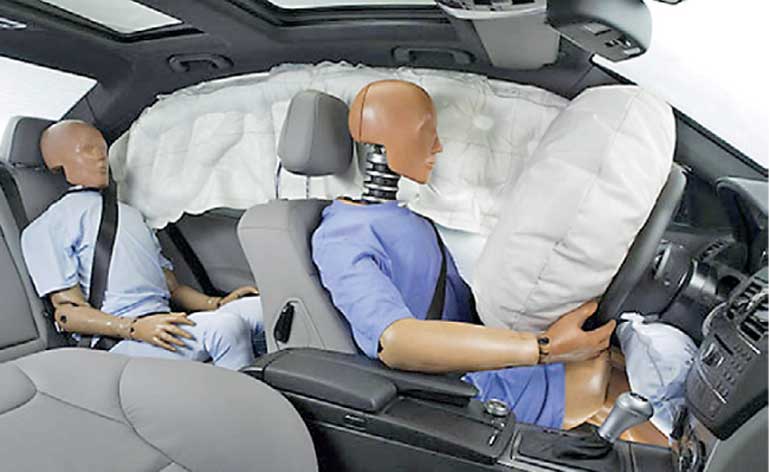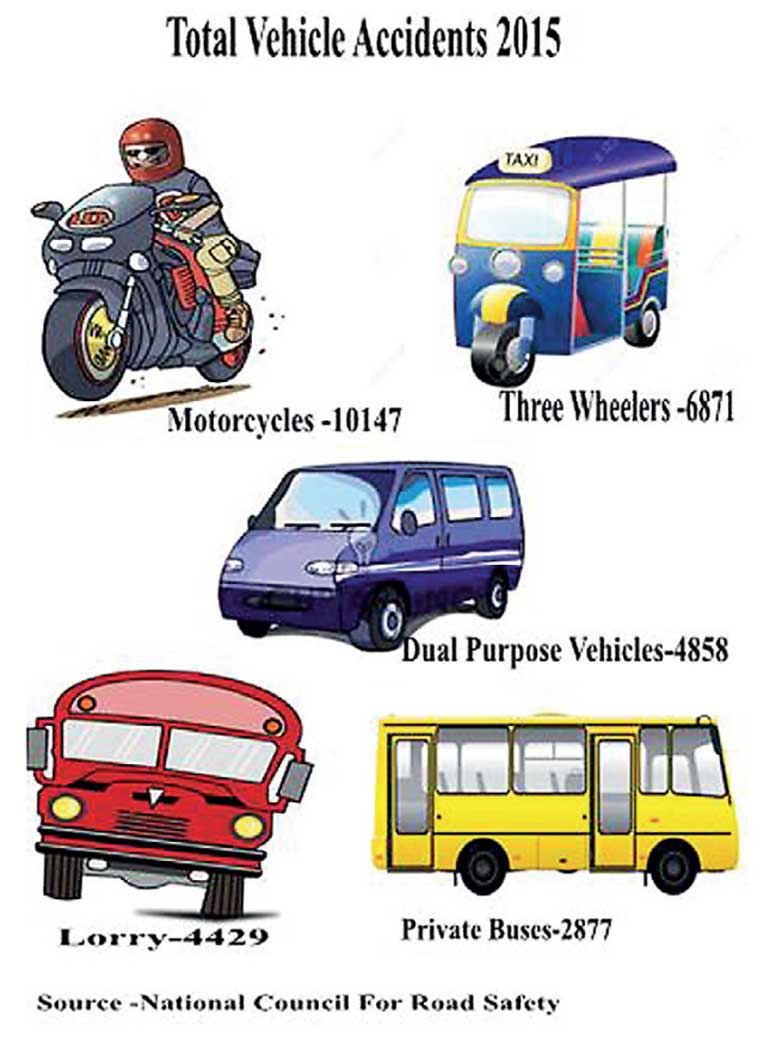Monday Oct 20, 2025
Monday Oct 20, 2025
Tuesday, 20 December 2016 00:03 - - {{hitsCtrl.values.hits}}
We often take things we do regularly for granted, like driving. We sometimes assume that we have the skills to handle all situations, even those rarely experienced – like driving in the snow or heavy fog.
Is there anything else you should be sure of when driving? How many of you have ever thought of the safety factor in your vehicle when you have thought of buying a vehicle? Whether it’s a brand new, recondition or second hand, an attention should be given on the safety precautions of the vehicle you intend buying.

Sri Lanka is a developing country and the vehicle usage has been increased many a times in recent 10 years and many brands has been introduced to the Sri Lankan market apart from the brands well established where most of them come from India, Japan, Thailand, Korea, Malaysia and from Europe as well.
Anticipating what might happen by looking ahead and closely observing the movement of other traffic wherever you drive, expecting the unexpected especially in city driving and take extra care when changing lanes, overtaking, going through intersections and driving at night, keeping a greater distance to the car in front especially when driving on rural roads and overtake only when safe – never rush or lose patience, taking a 15 minute powernap whenever you feel drowsy or sleepy, reducing your speed accordingly when driving conditions become difficult or extreme through rain, fog, snow or glare, not driving after you have been drinking or have taken drugs, not using a mobile phone while driving can be listed as the precautions you might take to avoid a crash.
But have you ever considered the condition of the vehicle might overpower all and end up with a crash which many lives could be taken away within a fraction of a second? The answer most probably could be “no”.

There is an international regulation for the safety of the vehicles. By their appalling disregard for road rules and lack of common sense Sri Lankans are needlessly putting their lives and the lives of others at great risk on a daily basis.
Minimum safety regulations for vehicles must be promulgated – it was heartening to hear that authorities are planning to insist on Driver’s Airbag and Anti-lock Brakes (ABS) as a minimum for all imported and locally assembled vehicles.
Sri Lanka lost 2,801 lives in 2015 from accidents and when you analyse the how they got themselves killed; the majority (36%) is from motorcycle riders with 1017 death in 10147 motorcycle crashes in 2015 which is a considerable number. In addition we can witness a 10% death rate in the section who ride normal bicycle amounting to 265. The total death occurred for drivers are 7% with 201 deaths in 2015.
Most cars, these days, are equipped with no shortage of standard features and a host of compelling options. But, with all manner of abbreviations and new technologies arriving in the ever expanding new-car market, how do you keep on top of what is worth your spend… and what isn’t?
According to a senior member of the Vehicle Importers’ Association of Sri Lanka, since there is no recommended regulation or legislation in Sri Lanka on the safely standard, vehicle buyers have to stick to the safety standards available in the vehicle they buy. He emphasised that such regulation is a need of the hour and it will have unique safety measurements which allow the buyers to buy a good quality vehicle with guaranteed safety precautions in such vehicles.

Total vehicle Accidents 2015
Considering the facts available more emphasis should be given to the safety of the motorcycles and it could be considered as the most dangerous mode of transport in Sri Lanka.
Many brands of motorcycles available in Sri Lanka and most of them are coming to Sri Lanka in bulk orders from India and China. They come as brand-new and recondition modes and sometimes as second hand models. Should there be any regulations imposed for the motorcycles when considering the safety of the vehicle.
David Peiris Motor Company (DPMC) is one of the pioneer companies which imports range of motorcycles to Sri Lanka over a considerable period of time. The writer contacted the Sales Manager of DPMC and he did not want to disclose whether they follow any safety regulations when they import the motorcycles.
Sri Lanka has nearly 1.3 million three wheelers operating on the road and they are the most vulnerable to accidents.
Three-wheelers, most of which are passenger carriers, have grown by a sharp 13.4% in the first six months of FY17, higher than the 12.34% growth seen in passenger vehicles (cars, utility vehicles and vans). Three-wheeler sales had grown by more than 1% in FY16.
The decision taken by the Government to discourage the use of three-wheelers was based on a number of economic and social factors, according to Finance Minister Ravi Karunanayake. He said that not having a proper monitoring system for three-wheelers as a self-employment avenue had caused these issues.
The Minister pointed out that it was a timely necessity to monitor the three-wheeler service of the country and it would be more efficient if proposals were presented by owners and drivers.
No company is bothered about maintaining such regulatory as Sri Lanka itself does not have anything to that effect to have any reference.
According to
National Council for Road Safety (NCRS) Chairman Dr. Sisira Kodagoda, they are now in the process of implementing and introducing a method of rectifying safety of all the vehicles in Sri Lanka
“No one has done this before. As the responsible authority of road safety in Sri Lanka, NCRS is developing a mechanism to rate on the safety of vehicles. We need to establish a technical and engineering unit comprise of experts in the field to prepare legislation in this aspect,” said Dr. Kodagoda, expressing the concern of having a unit of that nature in Sri Lanka similar to other countries
NCRS will introduce the new vehicle assessment programme. It will be designed to promote and conduct independent testing programmes that will assess the safety and environmental characteristics of motor vehicles.
Toyota Lanka Head of Sales Ashan De Silva feels that the introduction of such regulations is timely and essential, given the high volume of traffic on Sri Lankan roads and the requirement for international standard safety features with the increased usage of high speed highways for travel. The higher safety regulations will contribute towards reducing the number of fatalities and injuries to passengers with the increasing number of road accidents.
“A large number of vehicles imported to Sri Lanka do not have basic safety features. Irrespective of the brand and market competition, I strongly believe all vehicles should have safety features such as air bags, ABS, crumple zones, and reinforced passenger compartments in order to counter adverse probabilities created with the development of new roads, expressways and highways with high speed-limits and the rising density of vehicles on the roads. With the current road conditions, extra precautions should be taken to safeguard passengers as well as pedestrians when accidents occur. We at Toyota Lanka always place safety as an utmost priority and all our vehicles have very high ASEAN –NCAP ratings (New Car Assessment Program), which is the internationally-accepted system to assess the safety of a car with ratings given based on crash tests,” said De Silva.
Introducing safety standard when importing or producing will not the serve the purpose of reducing the rate of accidents in a country. Continuous monitoring is required to find out the condition of the vehicles and whether the owners maintain the required standards right throughout.
Safety of the vehicles is very important to reduce the occurrence of vehicle accidents and its consequences. A broader scope of vehicle safety which is road traffic safety broadly includes roadway design.
Purchasing a vehicle is perhaps one of the largest investments you will ever make, second to the purchase of your home. Therefore, your vehicle isn’t just a vehicle, it’s like property. In times of need, you can sell it for a less expensive model, and use the money for something useful. In times of success, you can trade it in for something that comes with even better features, benefits and looks
As vehicles improve with technological advancements, faster speeds have been attained and annoying little bumps as well as more serious accidents are by-products. Automobile manufacturers became more concerned with improving car safety and preventing injuries and deaths. It cannot be overstated how much car safety has improved over the years. But, with that said, accidents can and do continue to occur.
It is the responsibility of all motorists and passengers to strive for the safety of the vehicle. Not every accident can be prevented completely, but we as consumers can make good choices by selecting a safe vehicle for ourselves and our families, and use the restraint system.
